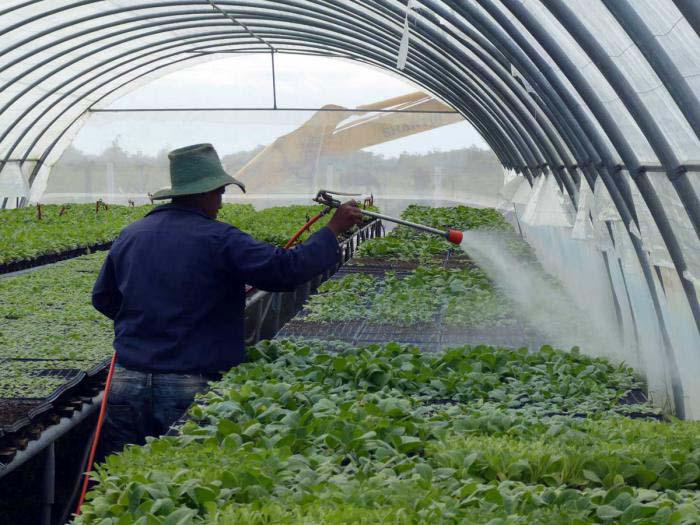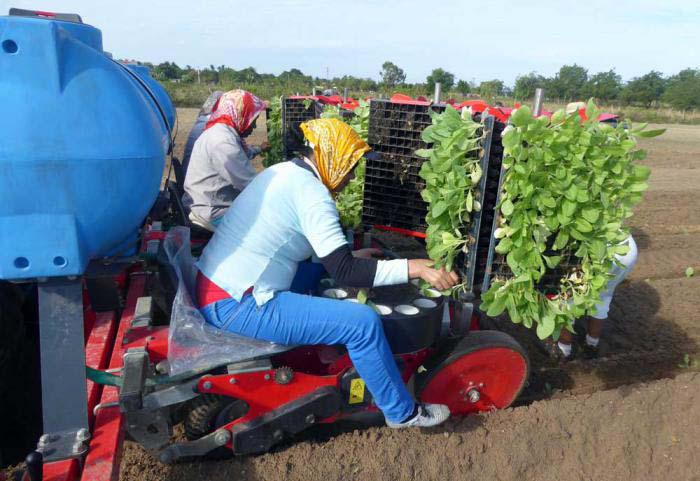
PINAR DEL RÍO.— "This works with sawdust, with rice husks, firewood, with chips..." explains Eddy Rodríguez, praising the advantages of the 20 climate-controlled curing chambers operated from a huge control panel, like a boy showing off a new toy.
Of all the latest generation facilities opened in Pinar del Río, to boost production of Virginia tobacco, the chambers that function with biomass, thanks to a system of multi-fuel boilers to which they are connected, have been decisive to re-launching a crop that disappeared from a good part of the province, precisely because of the high cost of fuel.
The objective is to supply a modern cigarette factory being built in the Mariel Special Development Zone (ZEDM) by the Cuban-Brazilian joint enterprise Brascuba S.A.
"All the raw material that that industry demands, we will obtain here," stated Virginio Morales, a specialist from the Tabacuba Enterprise Group, with certainty.
Toward that end, since a test run during the 2015-2016 season, acreage planted has been expanded every year on land where Virginia (popularly known as blond tobacco) was grown for decades, until its production became unsustainable.
Specialists recall that at least 0.8 liters of diesel were required to dry a kilogram of Virginia in controlled cure houses. Thus many growers of this type of tobacco, which given its taste and aroma was used in the production of mild cigarettes, switched to other crops.
Only in the municipality of Sandino and in a small area of Consolación del Sur was the its cultivation maintained.
Prospects for a new plant’s start-up this year, with a primary focus on exports, has put Virginia tobacco back on the map.
Carefully following a detailed development plan, which includes everything from the introduction of new varieties and special beds for seedlings, to innovative irrigation systems and a high degree of mechanization, the first step forward took place during the 2016-2017 campaign, with the planting of 101 hectares (ha) at the Julián Alemán farm near Consolación.
Other cooperatives in the same area and the municipality of San Luis would later join the effort.

Morales explained that, for the season just beginning, the goal is to reach 300 hectares (200 in Consolación and 100 in San Luis) and that in the near future the municipality of Pinar del Río will be incorporated.
The project will eventually include 947 ha, within the three areas.
This is easier said than done, since the introduction of Virginia tobacco in places where it was abandoned, some time ago, has required the training of producers and rehabilitation of infrastructure.
In this context, factors essential to the plan’s success include advice from Brazilian and Cuban specialists in the field; an important injection of technology that includes tractors and implements, dozens of controlled cure chambers; and the activation of a select team devoted exclusively to processing this type of tobacco.
Explaining why these municipalities on the southern plains of Pinar del Rio, and not elsewhere in the province or the country, the specialist recalled that since the first days of Virginia cultivation in the country, in the early 1900s, this region was chosen.
"It is a strip of sandy soil, with the necessary characteristics for its development," he stated.
Tractors coming and going, preparing the soil and planting the first fields, men on top of a metal frame putting the last touches on what will be a new greenhouse for seedlings, workers busy erecting ten new cure chambers... Santa Clara Point, one of the Virginia project’s two development areas in Consolación del Sur is currently experiencing the rigors of a campaign that will lay the foundation for multiplying acreage planted over the next two years.
Armando Caridad Ferro, in charge of the project at the Consolación tobacco company, reports that only 43 hectares are being planted this season, but that in 2021, there will be more than 200.
With more than 35 years experience working with Virginia tobacco, Armando speaks with optimism of the results being achieved and prospects for the program.
Historic yields here were around 0.8 or 0.9 tons per hectare (t/ha), he recalled, but we reached 1.2 in the first year of the project, and since then yields have continued to increase.
Last season we reached an average of 1.9 t/ha, with some growers exceeding 2.5.
Given these results, there has been no shortage of farmers interested in investing in Virginia.
Maximino Ramos is one of them, attracted by the technology that has been made available for the crop.
Pedro Antonio Cruz, another grower immersed in his first harvest near Santa Clara Point, agrees that the change is significant, "The land is plowed, sown, and fertilized mechanically. You see development everywhere.”
In this area alone, in the 2019-2020 season, some twenty producers will make their first foray into a crop that is reemerging in the region, and which will continue to expand over coming years.
"All these lands will be part of the project," explains Ferro, pointing toward the horizon, "The fields will reach as far as those mountains."
PRESIDENTIAL DIRECTIVES
-Develop productive chains with foreign investment, joint ventures, tourism, other sectors of the national economy and the non-state sector. This cannot be an empty slogan.
-Integrate all actors, forms of ownership and management present in the national socio-economic environment to increase the use of renewable energy sources; make investment processes more efficient; foster an environment of trust and security among those who invest in Cuba, taking the risk and facing threats.
-Increase exports and replace import with domestic products; put an end to overdue accounts payable and receivable; strengthen our negotiating capacity; modernize the banking system; prevent superfluous administrative expenses; and achieve real control of scarce resources.
-Develop economic ties between national producers and the tourist industry, conceived as the driving force of the Cuban economy.
-Eliminate obstacles that hinder the development of productive chains and seek solutions from our own economic actors.















